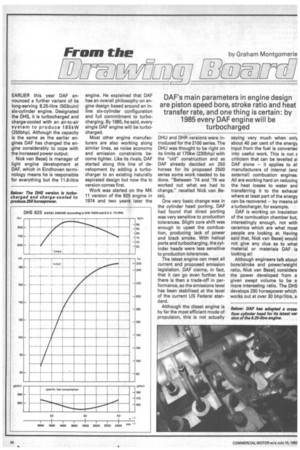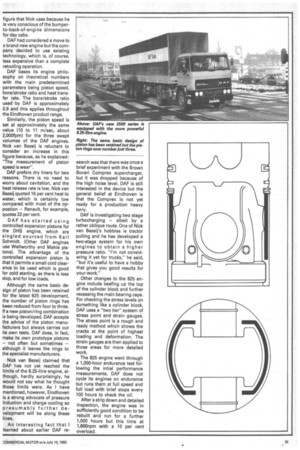DAF's main parameters in engine design are piston speed bore,
Page 32

Page 33

If you've noticed an error in this article please click here to report it so we can fix it.
stroke ratio and heat transfer rate, and one thing is certain: by 1985 every DAF engine will be turbocharged
EARLIER this year DAF announced a further variant of its long-serving 8.25-litre (503cuin) six-cylinder engine. Designated the DHS, it is turbocharged and charge-cooled with an air-to-air system to produce 1 85 kW (250bhp). Although the capacity is the same as the earlier engines DAF has changed the engine considerably to cope with the increased power output.
Nick van Bezeij is manager of light engine development at DAF, which in Eindhoven terminology means he is responsible for everything but the 11.6-litre engine. He explained that DAF has an overall philosophy on engine design based around an inline six-cylinder configuration and full commitment to turbocharging. By 1985, he said, every single DAF engine will be turbocharged.
Most other engine manufacturers are also working along similar lines, as noise economy and emission constraints become tighter. Like its rivals, DAF started along this line of development by adding a turbocharger to an existing naturally aspirated design but now the tc version comes first.
Work was started on the MK 11 version of the 825 engine in 1974 and two years later the
DHU and DHR versions were introduced for the 2100 series. The DHU was thought to be right on its limits at 170kw (230bhp) with the "old" construction and as DAF already decided on 250 horses for its proposed 2500 series some work needed to be done. "Between '74 and '76 we worked out what we had to change," recalled Nick van Bezeij.
One very basic change was in the cylinder head porting. DAF had found that direct porting was very sensitive to production tolerances. Slight core shift was enough to upset the combustion, producing lack of power and black smoke. With helical ports and turbocharging, the cylinder heads were less sensitive to production tolerances.
The latest engine can meet all current and proposed emission legislation. DAF claims, in fact, that it can go even further but there is then a trade-off in performance, so the emissions level has been stabilised at the level of the current US Federal standard.
Although the diesel engine is by far the most efficient mode of propulsion, this is not actually saying very much when only about 40 per cent of the energy input from the fuel is converted into useful work. This is not a criticism that can be levelled a1 DAF alone — it applies to all manufacturers of internal (and external) combustion engines. All are working hard on reducing the heat losses to water and transferring it to the exhaust where at least part of the energy can be recovered — by means of a turbocharger, for example.
DAF is working on insulation of the combustion chamber but, interestingly enough, not with ceramics which are what most people are looking at. Having said that, Nick van Bezeij would not give any clue as to what material or materials DAF is looking at!
Although engineers talk about bore/stroke and power/weight ratio, Nick van Bezeij considers the power developed from a given swept volume to be a more interesting ratio. The DHS develops 250 horsepower which works out at over 30 bhp/litre, a figure that Nick uses because he is very conscious of the bum perto-back-of-engine dimensions for day cabs.
DAF had considered a move to a brand new engine but the company decided to use existing technology, which is, of course, less expensive than a complete retooling operation.
DAF bases its engine philosophy on theoretical numbers with the main predetermined parameters being piston speed, bore/stroke ratio and heat transfer rate. The bore/stroke ratio used by DAF is approximately 0.9 and this applies throughout the Eindhoven product range.
Similarly, the piston speed is set at approximately the same value (10 to 11 m/sec, about 2,000fpm) for the three swept volumes of the DAF engines.
Nick van Bezeij is reluctant to consider an increase in this figure because, as he explained: "The measurement of piston speed is wear".
DAF prefers dry liners for two reasons. There is no need to worry about cavitation, and the heat release rate is low. Nick van Bezeij quoted 16 per cent heat to water, which is certainly low compared with most of the oppostion — Renault, for example, quotes 22 per cent.
DAF has started using controlled expansion pistons for the DHS engine, which are singled sourced from Karl Schmidt. (Other DAF engines use Wellworthy and Mahle pis tons). The advantage of the controlled expansion piston is that it permits a small cold clearance to be used which is good for cold starting, as there is less slop, and for low loads.
Although the same basic design of piston has been retained for the latest 825 development, the number of piston rings has been reduced from four to three. If a new piston/ring combination is being developed, DAF accepts the advice of the piston manufacturers but always carries out its own tests. DAF does, in fact, make its own prototype pistons — not often but sometimes — although it leaves the rings to the specialist manufacturers.
Nick van Bezeij claimed that DAF has not yet reached the limits of the 8.25-litre engine, although, hardly surprisingly, he would not say what he thought those limits were. As I have mentioned, however, Eindhoven is a strong advocate of pressure induction and charge cooling so presumably further development will be along these lines.
An interesting fact that I learned about earlier DAF re search was that there was once a brief experiment with the Brown Boveri Comprex supercharger, but it was dropped because of the high noise level. DAF is still interested in the device but the general belief at Eindhoven is that the Comprex is not yet ready for a production heavy lorry.
DAF is investigating two stage turbocharging — albeit by a rather oblique route. One of Nick van Bezeij's hobbies is tractor pulling and he has developed a two-stage system for his own engines to obtain a higher pressure ratio. "I'm not considering it yet for trucks," he said, "but it's useful to have a hobby that gives you good results for your work."
Other changes to the 825 engine include beefing up the top of the cylinder block and further recessing the main bearing caps. For checking the stress levels on something like a cylinder block, DAF uses a "two tier" system of stress point and strain gauges.
The stress point is a rough and ready method which shows the cracks at the point of highest loading and deformation. The strain gauges are then applied to those areas for more detailed work.
The 825 engine went through a 1,000-hour endurance test fol lowing the intial performance measurements. DAF does not cycle its engines on endurance but runs them at full speed and full load with brief stops every 100 hours to check the oil.
After a strip down and detailed inspection, the engine was in sufficiently good condition to be rebuilt and run for a further 1,000 hours but this time at 1,600rpm with a 10 per cent overload.












































